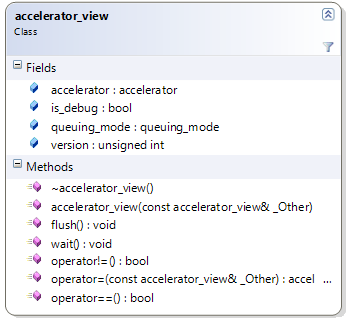concurrency::accelerator_view
Posted
by Daniel Moth
on Daniel Moth
See other posts from Daniel Moth
or by Daniel Moth
Published on Sun, 04 Sep 2011 03:32:32 GMT
Indexed on
2011/11/11
18:19 UTC
Read the original article
Hit count: 525
GPGPU
|ParallelComputing
Overview
We saw previously that accelerator represents a target for our C++ AMP computation or memory allocation and that there is a notion of a default accelerator. We ended that post by introducing how one can obtain accelerator_view objects from an accelerator object through the accelerator class's default_view property and the create_view method. 
The accelerator_view objects can be thought of as handles to an accelerator.
You can also construct an accelerator_view given another accelerator_view (through the copy constructor or the assignment operator overload). Speaking of operator overloading, you can also compare (for equality and inequality) two accelerator_view objects between them to determine if they refer to the same underlying accelerator.
We'll see later that when we use concurrency::array objects, the allocation of data takes place on an accelerator at array construction time, so there is a constructor overload that accepts an accelerator_view object. We'll also see later that a new concurrency::parallel_for_each function overload can take an accelerator_view object, so it knows on what target to execute the computation (represented by a lambda that the parallel_for_each also accepts).
Beyond normal usage, accelerator_view is a quality of service concept that offers isolation to multiple "consumers" of an accelerator. If in your code you are accessing the accelerator from multiple threads (or, in general, from different parts of your app), then you'll want to create separate accelerator_view objects for each thread.
flush, wait, and queuing_mode
When you create an accelerator_view via the create_view method of the accelerator, you pass in an option of immediate or deferred, which are the two members of the queuing_mode enum. At any point you can access this value from the queuing_mode property of the accelerator_view. When the queuing_mode value is immediate (which is the default), any commands sent to the device such as kernel invocations and data transfers (e.g. parallel_for_each and copy, as we'll see in future posts), will get submitted as soon as the runtime sees fit (that is the definition of immediate).
When the value of queuing_mode is deferred, the commands will be batched up. To send all buffered commands to the device for execution, there is a non-blocking flush method that you can call. If you wish to block until all the commands have been sent, there is a wait method you can call. Deferring is a more advanced scenario aimed at performance gains when you are submitting many device commands and you want to avoid the tiny overhead of flushing/submitting each command separately.
Querying information
Just like accelerator, accelerator_view exposes the is_debug and version properties. In fact, you can always access the accelerator object from the accelerator property on the accelerator_view class to access the accelerator interface we looked at previously.
Interop with D3D (aka DX)
In a later post I'll show an example of an app that uses C++ AMP to compute data that is used in pixel shaders. In those scenarios, you can benefit by integrating C++ AMP into your graphics pipeline and one of the building blocks for that is being able to use the same device context from both the compute kernel and the other shaders. You can do that by going from accelerator_view to device context (and vice versa), through part of our interop API in amp.h: *get_device, create_accelerator_view. More on those in a later post.
Comments about this post by Daniel Moth welcome at the original blog.
© Daniel Moth or respective owner